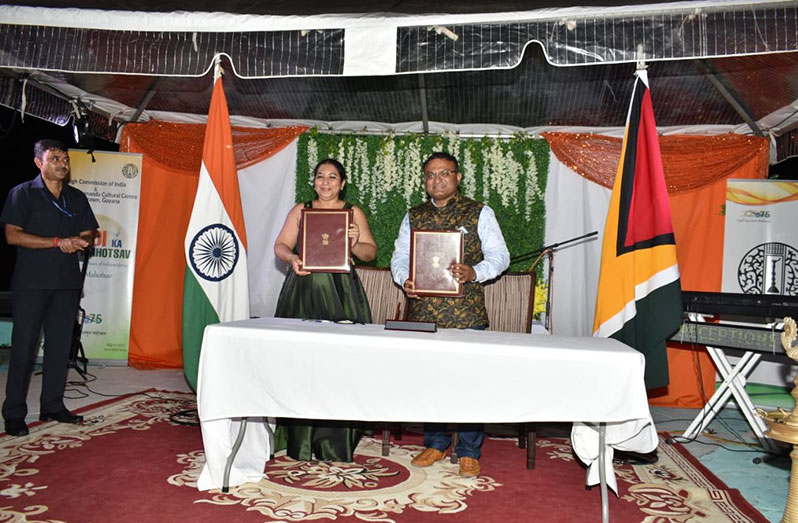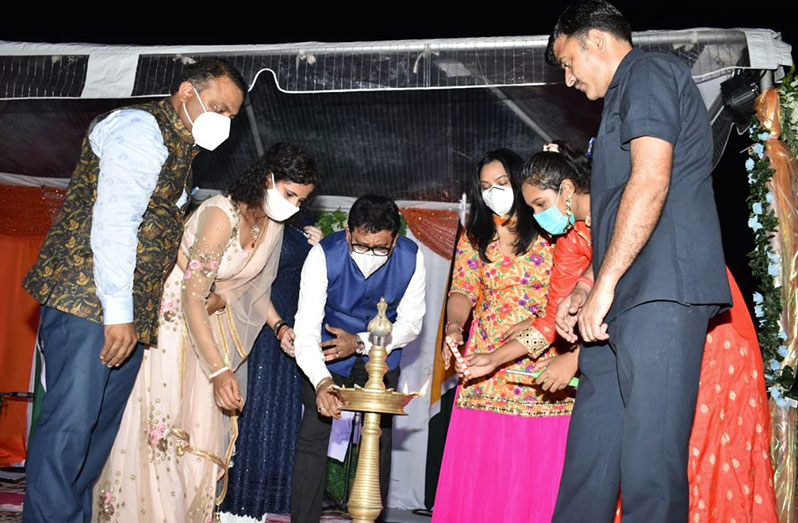THE High Commission of India and the Swami Vivekananda Cultural Centre (SVCC) in Georgetown celebrated Dussehra, which marks the end of Navratri and the triumph of good over evil by organising an event on the SVCC lawns last Friday.
According to a release, the event started with lighting of the ceremonial lamp by High Commissioner of India, Dr. K.J. Srinivasa; Chief Guest, Mohabir Anil Nandlall, Attorney-General and Minister of Legal Affairs; Dr. Vindhya V. Persaud, Minister of Human Services and Social Security and Vikram Bharrat, Minister of Natural Resources.
The guests were welcomed in the traditional style by the Tassa Group Band and the event comprised cultural performances including Lakshmi Vandana, Devi stuthi by the kathak teacher of SVCC, dance and music performances by the tabla teacher of SVCC, students of SVCC and family members of the High Commission.

The name Dussehra comes from the Sanskrit language “Dash” and “Hara.” It is said that it was on this day that Goddess Durga defeated Mahishasura (demon) after a fierce battle lasting for more than nine days. In many parts of the country, it is celebrated to mark the victory of Lord Rama over the 10-headed demon king of Lanka, Ravana.
Dussehra is celebrated in India in different states in different manner. In Karnataka, the people worship Goddess Chamundeshwari and a grand traditional Dussehra procession is held in Mysore.
Vijayadashami is celebrated in Kerala also as Vidyarambham (Vidya means knowledge, arambham means beginning), and on Vijayadashami day introduces young children into the world of knowledge, letters, and the process of learning. In Tamil Nadu, this festival is called Golu. This day, Bengalis celebrate Bijoya Dashami which marks the 10th day of Durga puja. In other parts of India, Dussehra is celebrated with much fanfare and Ram Lila, an enactment of Lord Rama’s story, is organised on all nine days of Navratri culminating with the killing of Ravana and burning of his life-size effigy on the day of Dussehra or Vijayadashami, along with those of Meghnad and Kumbhakaran, which signifies the end of evil.

“Dusshera also signifies getting rid of sins or bad qualities as each head of the Ravana symbolises one bad quality. Dussehra is a festival celebrated with great fervour, not just in India, but also in Nepal, and Bangladesh. It is the national holiday of Malaysia. This festival is also important to farmers as it marks the harvest of Kharif crops and sowing of rabi crops. While Dussehra signals the end of the nine-day long festival of Navratri, it also means beginning preparations for Diwali, which is celebrated 20 days after Vijayadashami, the day when Lord Rama reached Ayodhya with Sita,” the release said.
During the event, a Memorandum of Understanding (MoU) on the establishment of the Indian Council for Cultural Relations (ICCR), Chair of Indian Studies at the University of Guyana was signed between ICCR and UG. High Commissioner Dr. K J Srinivasa signed the MoU on behalf of the ICCR and Dr. Paloma Mohamed, Vice-Chancellor, on behalf of UG.
The event was attended by Indian nationals, Indian diaspora members, friends and well-wishers of India.



.jpg)








